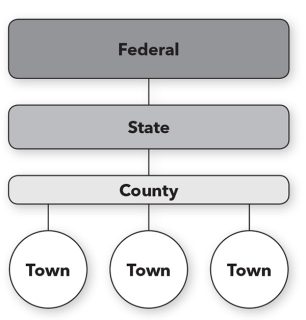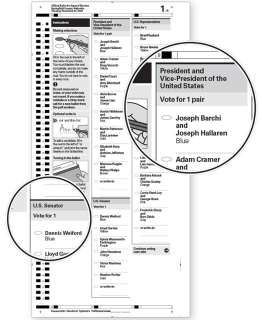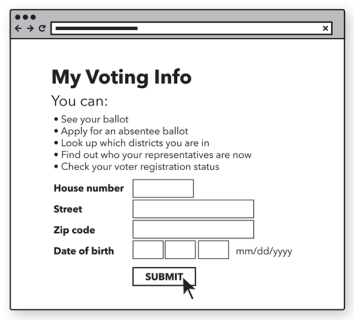Vol. 7 Designing election department websites
Voters increasingly rely on online sources for information about where to vote, what’s on the ballot, and when they can vote. But some voters are unaware that their county, parish, or town even has a website about elections.
Finding local election information
When voters aren’t sure about where to go and what to do when they find a polling place, they’re less likely to vote at all.
When they search for elections information, they might start with their city or town, their county, or their state, depending on what they are looking for, so it’s important that all of these options lead to accurate information.
They want to be ready to vote. They want to know what will be on their ballot, so they can prepare. First-time voters need to know what voting is like. Long-time voters need to know what’s new.
Creating a website that answers voters’ questions will help make confident voters who show up at the right place with everything they need to vote.
The 10 guidelines in this Field Guide come from research done in 2012 by 32 amazing volunteer researchers. We cataloged 147 county or town websites and then conducted 40 usability test sessions in which we observed voters trying to find answers to their questions about the upcoming election.
No. 01
Help voters find your website.
Including the words that people search for in your website’s name, headings, and text will help people get to the right place.
Consider including these words in your site’s metadata*:
- election
- vote
- ballot
- register
- absentee
- voter ID
- results
- district
- contact
- the name of your county and largest towns
* Search engines look at text elements in the HTML as data that describes the content of the site, that is, metadata.
No. 02
Connect your website to other government sites.
Voters start by looking for information locally. They often search for their town or county name plus “elections,” which leads them to a local site.
But you don’t have to have all election information on your website.
Link levels of government
Connect your election website to other levels of government. Use links that help voters know where they’ll end up, such as, “Find your polling place on the state board of elections website.”
No. 03
Answer the question: ‘What’s on the ballot?’ Show an example.
Voters want to know what’s going on ahead of time, and they want to be sure of what they’re doing when they mark the ballot.
Sample ballots do not have to be the exact ballot, but should show the ballot’s format and a list of what will be on the ballot.
No. 04
Group navigation to answer voters’ questions.
Rather than organizing the site around how the department or board is organized, anticipate — and answer — voters’ questions.
List options together. For example, have all the options for voting listed together in links leading to their own pages.
Ways to vote
Vote by mail
Vote early in person
Vote at the polls in person
Where to vote
Find your polling place
Vote center locations
No. 05
Help visitors know what site they are on and what will be covered there.
The purpose of the website is to answer questions rather than advertise the election department or board of elections.
The top of the web page (the banner) should:
- Show the name of the county, town, parish, or borough.
- Include the authority behind the site, such as the clerk, registrar, or board — by title and name. Having a small photo is nice.
- Leave the maximum room on the page for content that answers voters’ questions.
No. 06
Write links that use words voters use and that help voters know where they will end up.
Links and headings that are worded as questions work well.
The top 5 questions we saw in our research with voters were:
- What is on the ballot?
- How do I get an absentee ballot and when is it due?
- Where do I vote?
- Who is in office now?
- How do I register to vote?
No. 07
Put the most important information in the main menu or the center section of the page.
Studies show that more than 40% of US adults have low literacy.
People with low literacy read straight down the middle of a page — and miss content to the left and right.
No. 08
Help voters find ballot information, especially if sample ballots are within a widget or a wizard.
Polling place finders and voter information look-ups often hide ballot information that voters are looking for.
Tell voters why they’re providing personal information to get their ballot and registration information. Most voters don’t know that doing so gives them the specifics of their ballot.
No. 09
Use words that voters use in links, headings, and graphics.
Avoid using election jargon such as “sample ballot” and “affiliation.”
Instead of “sample ballot,” just say “ballot” or “example ballot” or “your ballot.”
To answer their questions, voters in our study looked for words and phases like these, in this order:
- ballot
- voting options, early voting, absentee voting, or voting by mail
- current office holders
- where to vote
- voter ID
- register to vote
- what to expect [at the polling place]
- how to vote [using the system]
- military and overseas voters
- election results
No. 10
Help voters see at a glance what each chunk of information is about.
- Use clear, simple, headings in plain language.
- Decide what’s most important and emphasize that.
- Be as specific as possible.
- Use bulleted lists rather than long paragraphs.
For example:
Absentee voting
You can vote even if you cannot get to the polling place on Election Day. Find out how to vote “absentee” and check the status of your absentee ballot.
Election day
Find out where your polling place is, what is on the ballot, and view election results.
Voter registration
Find out if you are registered, learn how to register, or update your registration





